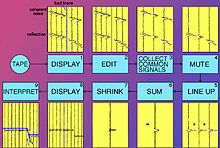Signal processing
This article has multiple issues. Please help improve it or discuss these issues on the talk page. (Learn how and when to remove these template messages)
|


Signal processing is an
History
According to Alan V. Oppenheim and Ronald W. Schafer, the principles of signal processing can be found in the classical numerical analysis techniques of the 17th century. They further state that the digital refinement of these techniques can be found in the digital control systems of the 1940s and 1950s.[3]
In 1948,
Signal processing matured and flourished in the 1960s and 1970s, and digital signal processing became widely used with specialized digital signal processor chips in the 1980s.[5]
Definition of a signal
A signal is a function , where this function is either[6]
- deterministic (then one speaks of a deterministic signal) or
- a path , a realization of a stochastic process
Categories
Analog
Analog signal processing is for signals that have not been digitized, as in most 20th-century
Continuous time
The methods of signal processing include
Discrete time
Analog discrete-time signal processing is a technology based on electronic devices such as sample and hold circuits, analog time-division multiplexers, analog delay lines and analog feedback shift registers. This technology was a predecessor of digital signal processing (see below), and is still used in advanced processing of gigahertz signals.
The concept of discrete-time signal processing also refers to a theoretical discipline that establishes a mathematical basis for digital signal processing, without taking
Digital
Digital signal processing is the processing of digitized discrete-time sampled signals. Processing is done by general-purpose
Nonlinear
Polynomial signal processing is a type of non-linear signal processing, where polynomial systems may be interpreted as conceptually straightforward extensions of linear systems to the non-linear case.[9]
Statistical
Statistical signal processing is an approach which treats signals as stochastic processes, utilizing their statistical properties to perform signal processing tasks.[10] Statistical techniques are widely used in signal processing applications. For example, one can model the probability distribution of noise incurred when photographing an image, and construct techniques based on this model to reduce the noise in the resulting image.
Application fields

- speech or music[11]
- Image processing– in digital cameras, computers and various imaging systems
- Video processing – for interpreting moving pictures
- Wireless communication– waveform generations, demodulation, filtering, equalization
- Control systems
- Array processing – for processing signals from arrays of sensors
- Process control – a variety of signals are used, including the industry standard 4-20 mA current loop
- Seismology
- Financial signal processing – analyzing financial data using signal processing techniques, especially for prediction purposes.
- image understanding and speech recognition.
- Quality improvement, such as echo cancellation.
- Source coding including video compression.
- Genomic signal processing[12]
- In time-series measurements of geophysical data. Processing is conducted within either the time domain or frequency domain, or both.[13][14]
In communication systems, signal processing may occur at:
- OSI layer 1 in the seven-layer OSI model, the physical layer (modulation, equalization, multiplexing, etc.);
- OSI layer 2, the forward error correction);
- OSI layer 6, the presentation layer (source coding, including analog-to-digital conversion and data compression).
Typical devices
- stochastic filters, etc.)
- Samplers and analog-to-digital converters for signal acquisition and reconstruction, which involves measuring a physical signal, storing or transferring it as digital signal, and possibly later rebuilding the original signal or an approximation thereof.
- Signal compressors
- Digital signal processors (DSPs)
Mathematical methods applied
- Differential equations[15]
- Recurrence relations[16]
- Transform theory
- Time-frequency analysis – for processing non-stationary signals[17]
- Spectral estimation – for determining the spectral content (i.e., the distribution of power over frequency) of a time series[18]
- Statistical signal processing– analyzing and extracting information from signals and noise based on their stochastic properties
- Linear time-invariant system theory, and transform theory
- Polynomial signal processing– analysis of systems which relate input and output using polynomials
- System identification[7] and classification
- Calculus
- Complex analysis[19]
- Vector spaces and Linear algebra[20]
- Functional analysis[21]
- stochastic processes[10]
- Detection theory
- Estimation theory
- Optimization[22]
- Numerical methods
- Time series
- Data mining – for statistical analysis of relations between large quantities of variables (in this context representing many physical signals), to extract previously unknown interesting patterns
See also
- Algebraic signal processing
- Audio filter
- Bounded variation
- Digital image processing
- noise gating
- Fourier transform
- Information theory
- Least-squares spectral analysis
- Non-local means
- Reverberation
- Sensitivity (electronics)
References
- PMID 27286184.
- ISBN 0-13-216771-9.
- ISBN 0-13-214635-5.
- ^ "A Mathematical Theory of Communication – CHM Revolution". Computer History. Retrieved 2019-05-13.
- ^ a b Fifty Years of Signal Processing: The IEEE Signal Processing Society and its Technologies, 1948–1998 (PDF). The IEEE Signal Processing Society. 1998.
- ^ Berber, S. (2021). Discrete Communication Systems. United Kingdom: Oxford University Press., page 9, https://books.google.com/books?id=CCs0EAAAQBAJ&pg=PA9
- ^ ISBN 978-1-119-94359-4.
- S2CID 52153144.
- ISBN 978-0-471-03414-8.
- ^ OCLC 61160161.
- S2CID 220665533.
- .
- ISBN 978-0-521-33938-4.
- ISBN 978-0-471-48535-3.
- ISBN 978-0-85296-431-6.
- ISBN 978-1-84800-119-0.
- ISBN 0-08-044335-4.
- ^ Stoica, Petre; Moses, Randolph (2005). Spectral Analysis of Signals (PDF). NJ: Prentice Hall.
- ISBN 978-1-139-48762-7.
- ISBN 978-0-19-102431-3.
- ISBN 978-1-107-01322-3.
- ISBN 978-0-521-76222-9.
Further reading
- P Stoica, R Moses (2005). Spectral Analysis of Signals (PDF). NJ: Prentice Hall.
- Kay, Steven M. (1993). Fundamentals of Statistical Signal Processing. OCLC 26504848.
- Papoulis, Athanasios (1991). Probability, Random Variables, and Stochastic Processes (third ed.). McGraw-Hill. ISBN 0-07-100870-5.
- Kainam Thomas Wong [1]: Statistical Signal Processing lecture notes at the University of Waterloo, Canada.
- ISBN 978-0-470-25388-5.
- ISBN 978-0-13-022464-4.
External links
- Signal Processing for Communications – free online textbook by Paolo Prandoni and Martin Vetterli (2008)
- Scientists and Engineers Guide to Digital Signal Processing – free online textbook by Stephen Smith
- Julius O. Smith III: Spectral Audio Signal Processing – free online textbook



